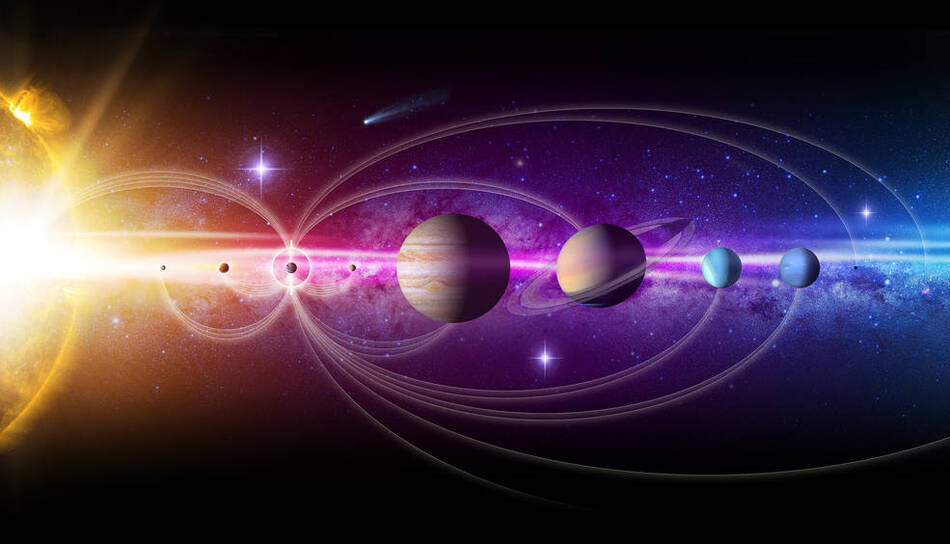
A common question posed to Vedic Astrologers is what is the relationship between Astrology and Astronomy? They both focus on the stars. Are they the same discipline of study? If not, then how do they differ? Do Astrology and Astronomy share principles and collaborate with each other? If no, why not?
Astrology and Astronomy historically were considered the same discipline of study for millennia. They began separating in the 17th century CE and were completely separated by the 18th. Astrology investigates and connects the influence of celestial occurrences on human life and earthly events. Astronomy and its sister disciplines Cosmology and Astrophysics study the formation, characteristics, and physics of the universe.
Why did these two disciplines separate and remain separated up to today? They certainly are not diametric opposites. In fact, there are many similarities between the two. So what was the impetus for the split?
Put simply, the separation occurred largely because of an academic turf war – one in which Astronomy emerged victorious. In the aftermath, Astronomy took its place among other scholarly disciplines at institutions of higher learning and Astrology was banished to the fringes of pseudoscience.
But was this fair? Let’s explore it further and decide for ourselves.

Dr. YV Subba Rao at the University Science and Instrumentation Centre, Sri Venkateswara University, India identifies four major astronomical discoveries that prompted the Astrology-Astronomy rift.[1]
- Precession of Equinoxes
- Heliocentric system
- Discovery of the outer planets
- The vast distances in space
What are these discoveries and how do they relate to the separation of Astrology and Astronomy? It is important to remember that for centuries they were seen as the same discipline of study, two sides of the same coin.
In each case, Astronomy used the discovery to elevate itself above Astrology and to eventually expel it from their realm of science entirely.
Precession of Equinoxes

This is a technical reference. Let’s unpack it so that we can better understand what it means going forward. We’ll start by defining what is an equinox and proceed from there.
What is an Equinox?
Equinox refers to the specific point at which the path of the Sun crosses the surface of the earth’s equator. This results in night and day being approximately the same length of time all over the world. There are two times in a year when this occurs. The vernal or spring equinox happens on or about March 21 and the autumnal equinox takes place on or about September 22.
Now let’s tackle precession.
What Does Precession Mean?
This is a little more challenging. Let’s try to break it down so that it’s understandable.
The Earth has three motions.
- Rotation. It completes one rotation on its axis approximately every 24 hours, creating the day and night cycle.
- Revolution. It orbits the Sun once each year.
- Wobble. It wobbles on its axis, completing one circular wobble approximately every 26,000 years. This is known as the great year.
It is the third motion – the wobble – that pertains to precession.
The Earth doesn’t orbit the sun in the tight symmetrical pattern often portrayed in simple animations. Instead, Earth’s orbit is elliptical (oval) and it wobbles like a spinning toy top as it circles the Sun. The wobble occurs because the orbital tilt of Earth’s axis of rotation, known as obliquity, is 23.5° off vertical. This tilt is responsible for the Earth passing through different seasons.
Not only is the Earth tilted, it has a bulging midriff! To understand this, let’s imagine that you are riding in the backseat of a car behind the driver and it suddenly makes a sharp right turn.
What happens?

Your body accelerates in the direction opposite of the turn (to the left) and you are pushed against the left door of the car.
A similar force of acceleration occurs as the Earth spins on its axis. This causes the Earth to bulge along the equator, where it is 41.8 kilometers (25 miles) wider and actually spins faster compared to other parts of the globe.
Because the Earth is not a perfect sphere, gravitational forces exerted by the Sun, Moon, and surrounding planets are unbalanced. One side of the Earth is subject to a slightly stronger pull than the other. This, along with the 23.5° tilt, results in the Earth’s wobble, a phenomenon known as precession of the Earth’s axis.
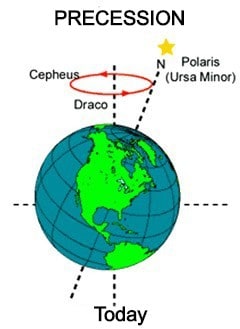
The axis is figurative, meaning that it’s an imaginary line extending from the North and South Poles. It is useful for understanding precession. As shown in the figure, over a period of about 26,000 years, the Earth’s axis traces out a circle in the sky (red arrow). This is an extremely slow process. The Earth wobbles only one degree of the circle (360°) every 72 years!

One result of this is that the North Star changes over this long period of time. Currently, the Earth’s axis points toward the star Polaris and it will do that for all of our lives. But, as the figure reveals, five thousand years ago, the axis pointed to a star in the constellation Draco, and 11,000 years ago the bright star Vega was the pole star. Because of the 26,000 year cycle, Vega will be the pole star again in 14,000 years.
Now that we know what equinox and precession mean, let’s address precession of the equinoxes.
What Is Precession of the Equinoxes?
Precession of the equinoxes refers to the relationship between the Earth’s rotational spin, its oscillation, and its orbital motion around the Sun. Specifically, it is how the wobbling of the earth’s axis of rotation causes the earlier incidence of the equinoxes each year due to the slow backward motion of the two points of the equinox along an imaginary line in the sky that marks the annual path of the sun.
Whoa!
Let’s back up for a minute and see if we can understand this. First, we need a reference structure called the celestial coordinate system.
Celestial Coordinate System
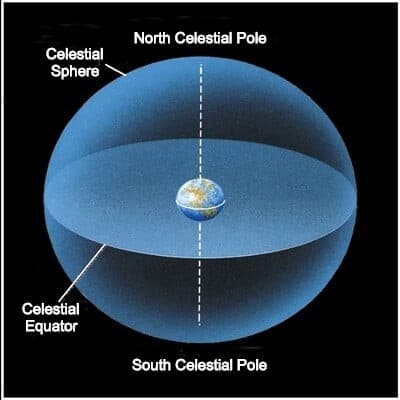
As the figure shows, the celestial coordinate system basically is an imaginary giant sphere. It is a perfect sphere with a north celestial pole (NCP), a south celestial pole (SCP), and a celestial equator.
If we superimpose the Earth with its tilt onto the celestial coordinate system, as shown in the figure below, we can see that its equatorial plane is at a 23.5° angle relative to the celestial equator. The points where these two intersect are the vernal and autumnal equinoxes.
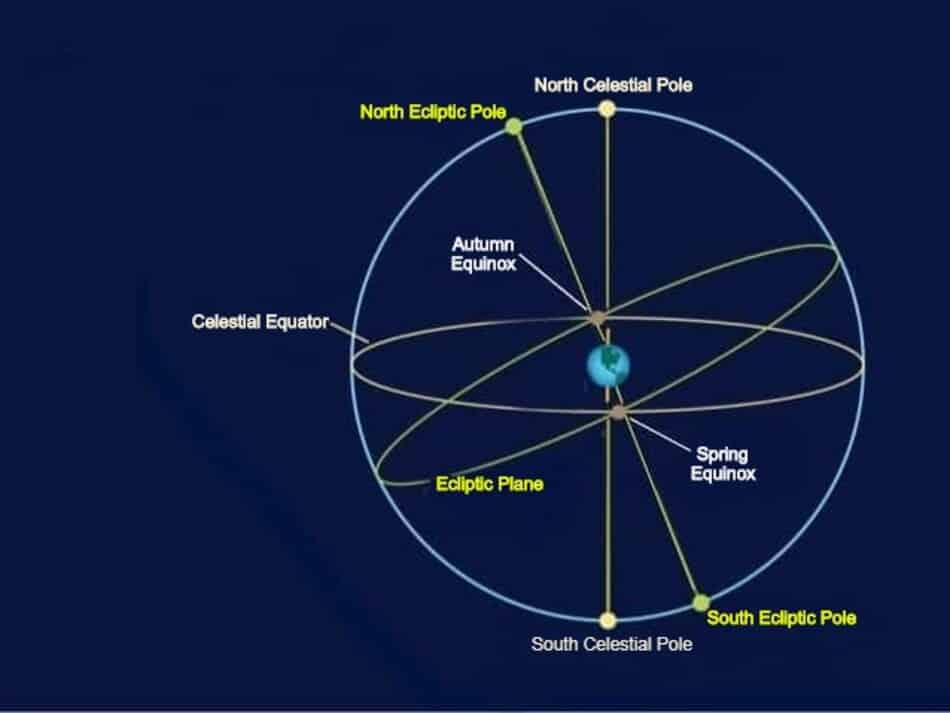
If the Earth didn’t wobble on its rotational axis, it would simply spin continuously and the points of the two equinoxes always would remain the same (all other things being equal). However, the Earth does wobble and this causes a slight drift of the equinox points relative to the celestial equator.
Over time, this would mean that the seasons also would occur at times different than to which we are accustomed. To create a more predictable system, Astronomy introduced modifications to ensure that the vernal equinox always would be on March 20 or 21st. This forces the seasons to occur during the same months, regardless of the drift caused by precession.
The first of these modifications was the mandate of the Julian calendar by Julius Cesar, which introduced the concept of a leap year. A day was added to February every four years. This was supplanted by the Gregorian calendar, which remains in use today, to further adjust the timeline. Use of the leap year continued, but if a candidate year was exactly divisible by 100 it was initially rejected, unless it also was exactly divisible by 400, in which case it was implemented.
Wow!
That’s a lot of effort just to make sure that the seasons occur in a predictable pattern!
Vedic Astrology also implemented its own adjustment called the ayanāṁśa for the gradual precession of the vernal equinox.
A complete precession of the equinoxes requires about 26,000 years. This means that the slightly earlier incidence of the equinoxes each year due to precession is not noticeable during our lifetimes. However, as we have just learned, it does have implications for the development of a standardized calendar year and how we measure time.
Measurement of a Calendar Year
A year on Earth is measured by one complete orbit around the Sun. Everyone knows this. Right?
But there’s a problem.
The Earth’s orbit is not spherical, it’s elliptical (oval). Specifically, the Earth doesn’t travel in a route around the Sun that returns to its starting point, because the Sun also is in motion. This causes the path of Earth’s elliptical orbit around the Sun over time to look more like a corkscrew, rather than an unchanging circle with a fixed beginning and end.
You might be asking yourself. So how do we know when a year starts or ends? Let’s investigate that.
The Sidereal Year
One way to determine the beginning and ending of one year, known as the sidereal year, measures Earth’s orbit against distant stars. Viewed from our perspective here on Earth, the spinning of our planet on its axis causes the Sun to appear to move through the 12 constellations of the Zodiac on a path called the ecliptic.
For example, in January, the Sun is in the constellation Capricorn. As time passes, the Sun progresses through all of the constellations of the zodiac. When it returns to Capricorn, it has completed a sidereal year.
Passage of the Sun through the constellations is not easy to monitor directly, because we can’t observe the stars when the Sun is shining in the sky. However, the annual motion is very apparent if we examine the sky before each dawn.
The last stars observed to rise at dawn are not always the same. Within about 14 days, a change can be identified. To illustrate, we can’t see the constellation Orion in the dawn sky in July in the northern hemisphere. However, it is clearly visible in August.
Calculating this way, a sidereal year results in a period that is 365 days, 6 hours, 9 minutes, and 10 seconds long.
Orbital Eccentricity

The eccentricity of the Earth’s orbit also supports the definition of a sidereal year. We’ve already learned that Earth’s orbit is elliptical. Over a period of 100,000 years, this varies from low eccentricity to higher eccentricity. During periods of low eccentricity, the Earth revolves around the Sun in a more circular motion, with either zero or a low percent difference between its farthest distance (aphelion) from the Sun to its closest distance (perihelion). Earth is currently in the low eccentric shape of about 3 percent.
Conversely, during periods of high eccentricity, the Earth revolves around the Sun in a more oval motion with one side of the oval being closer to the Sun and a difference of 10 percent between the aphelion and perihelion. Orbital eccentricity fluctuates due to gravitational attractions among the planets, the strongest coming from Jupiter and Saturn.
As the eccentricity of the orbit progresses over time, the longest diameter of it that runs through the center with ends at the widest points of the perimeter, known as the major axis of the orbital ellipse, remains unchanged. This means that the length of the sidereal year also remains unchanged.
The Tropical (or Synodic) Year
Another possibility is to measure a year according to the passing of the seasons. This is referred to as a tropical (synodic) year and it returns us to the concept of precession of the equinoxes.
The tilt of the Earth on its axis causes the position of the Sun in the sky to change from day to day throughout the year. If we were to take a picture of the Sun at noon on Monday of each week for a year, we would see the Sun moving on the route presented in the figure, called an analemma.
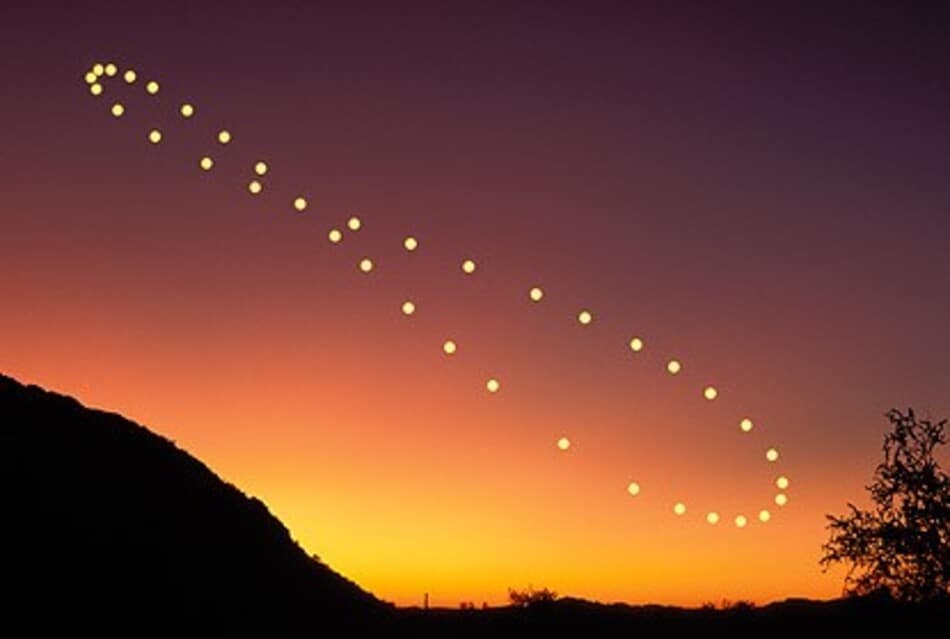
On the days of its revolution around the Sun when the Earth is at its maximum tilt towards the Sun, the length of the daylight is at a maximum. When the maximum tilt is away from the Sun, daylight is at a minimum. These days are called solstices and they represent the first day of summer and winter. At the summer solstice, the Sun will be at the top left of the analemma; at the winter solstice, the bottom right.
On the two days of the year when the Earth’s tilt is perfectly sideways to the Sun, day and night are equal in length. These are known as the vernal (spring) and autumnal equinoxes. The equinoxes occur at the crossover position of the analemma.
We mentioned previously that precession of the equinoxes refers to the manner in which the wobbling of the earth’s axis causes the slightly earlier incidence of the equinoxes each year due to the slow backward motion of the two points of the equinox along an imaginary line in the sky that marks the annual path of the sun. We now know that this imaginary line is the analemma.
When the Sun travels from one vernal equinox to the next, a tropical (synodic) year has completed. Calculating this way, results in a year that is 365 days, 5 hours, 48 minutes and 46 seconds long.
But aren’t we right back where we started? Sidereal and synodic years give us two different measurements that differ by about 20 minutes. So which one is right?
This has been a matter of intense debate for a very long time. Most Western astrologers use the tropical year in their calculations. In this configuration, steps were taken to ensure that the seasons occur during the same months, but we view different constellations during those months. On the other hand, Most Vedic astrologers use the sidereal year for their calculations. For this calendar, constellations are observed in the same months, but the seasons wind up being assigned to different months over time.
Notice that for both sidereal and tropical systems, the seasons occur with the same periodicity as they have for the millennia of recorded history and probably millions of years before that. However, what has evolved is our ability to categorize what we observe happening around them.
Categorization is the key concept here. Tropical and Sidereal systems are means of categorization that help us to better understand the complexities of celestial processes. As a result, both carry the same inherent flaws that accompany categorization. In truth, the issue is not one of right or wrong, accuracy or inaccuracy, but one of context and perception.
Astronomers frequently question the accuracy of astrological readings that use points of reference that change over time to make calculations. This certainly is an irrelevant argument against Vedic astrology, which specifically factors precession into its chart calculations through the ayanāṁśa.
The irony for Astronomy is that the sidereal year used in Vedic Astrology actually corresponds better to astronomical observations. It also is important to remember that, while the tropical year succeeds in being a convenient system, it achieves this by manipulating natural phenomena to conform to an orderly predictable pattern.
This brings us to the critical question. Is precession of the equinoxes enough of a reason for Astrology and Astronomy to have separated? Perhaps no; maybe yes.
You decide.
The Heliocentric System


In Western history books and science texts, the Polish astronomer and mathematician Nicolas Copernicus (1473-1543 CE) is credited with developing a model of the universe that located the Sun at the center instead of Earth. This is known as the Heliocentric model. However, the Greek astronomer Aristarchus of Samos (310-230 BCE) forwarded a similar theory nearly two millennia before Copernicus.
Prior to this a Geocentric model was favored and enthusiastically supported by religious authorities, in which the Earth is the center of the universe. However, it is notable that Muslim astronomers began to question Geocentrism 400 years before Copernicus in the 10th century CE.
Heliocentrism was further supported by the telescopic observations of Galileo Galilei (1564-1642 CE) and the mathematical demonstration of the elliptical orbits of planets by Johannes Kepler (1571-1630 CE).
In truth, neither Geocentrism nor Heliocentrism are correct. However, the Heliocentric model was modified later in the 19th century in response to contributions made by astronomers Frederick William Herschel (1738-1822 CE), Friedrich Bessel (1784-1846 CE), and other contemporaries that clearly demonstrated that our Sun is not the center of the universe.
Although we now know that Heliocentrism in its original context is a misnomer, it still is used today, partly out of tradition and partly because it is true that the Sun is the center of our solar system.
Critics appear to be under the impression that Vedic astrologers either were ignorant of the Heliocentric model or rejected it and adhered to Geocentrism anyway. Both are easy to dispel.
The concept of Heliocentrism is referred to in a number of Vedic texts written by sages in ancient India.

The Hindu Vedic sage Yajnavalkya (8th century BCE) is considered to be one of the earliest philosophers in recorded history. He identified the Earth and other planets as being spherical and that the Sun was the center of the spheres.
The Sun strings these worlds – the earth, the planets, the atmosphere – to himself on a thread.
Yajnavalkya (Śatapatha Brāhmaṇa – 8.7.3.10)
The Vedic Sanskrit text Aitareya Brahmana (7th century BCE) also presents a viewpoint that is decidedly Heliocentric.
The Sun never sets or rises. That’s right. When people think the Sun is setting, it is not so; they are mistaken.
Mahidasa Aitareya (Aitarreya Brahmana – 2.7)

Finally, in his crowning achievement, the Aryabhatiya, the Indian astronomer and mathematician Aryabhata (476 – 550 CE) introduced a detailed Heliocentric model. He proposed that the Earth was spinning on its axis and the orbits of the planets occurred with respect to a stationary Sun.
Aryabhata also discovered that light from the Moon and the planets was reflected from the Sun, that the planets have elliptical orbits around the Sun, and accurately calculated many astronomical constants. He did this nearly a millennium before Copernicus expressed his ideas.
These are but a few among many examples in ancient Indian texts in which advocacy for Heliocentrism occurs. However, it is true that Vedic Astrology does use geocentric concepts. For example, the natal chart is a snapshot of the sky at the moment of your birth taken from a geocentric view.
Astronomy also uses Geocentrism. A good example are planetariums, of which there are in excess of 6,000 worldwide. Planetariums are theaters of Astronomy that present the celestial sky from the vantage point of looking up from the Earth, a geocentric view.
What?
I thought that Astronomy had rejected Geocentrism.
It is true that they have, but choosing to present the celestial sky from a Geocentric view in this case makes sense. Why would planetariums seek to show a view of the night sky from the vantage point of, for example, the planet Neptune?
First, it currently is impossible. No permanent vantage point from Neptune exists that would enable astronomical observations to be made. Second, even if at some point in the future a vantage point from Neptune were possible, it would be impractical, particularly when we have a perfectly good frame of reference to view the stars right here on Earth.
Vedic Astrology uses both geocentric and heliocentric models in the genesis of its principles.
Dr. YV Subba Rao
In Vedic Astrology, right ascension and declination are examples of geocentric coordinates used in Earth-based observations. At the same time, Vedic Astrology uses heliocentric references to latitude and longitude for orbital calculations. However, selection of these frames of reference is done strictly for calculation purposes. It neither has philosophical significance nor does it promote a specific physical or scientific model of the universe.
We can see clearly from this analysis both Vedic Astrology and Astronomy acknowledge the heliocentric model. However, both also employ a geocentric perspective when it is convenient or practical to do so.
This returns us to our original question. Is this enough of a reason for Astrology and Astronomy to have separated? Perhaps no; maybe yes.
You decide.
Discovery of the Outer Planets

Vedic Astrology has worked with the following celestial bodies in our solar system for millennia.
- Sun
- Moon
- Mercury
- Venus
- Mars
- Jupiter
- Saturn
Critics claim that discovery of the outer planets in our solar system: Uranus, Neptune and Pluto, was a crushing blow that resulted in an enormous shake up of Vedic Astrology.
This is untrue. Their argument rests on the assumption that ancient vedic astrologers were unaware of the existence of the outer planets and that current practitioners stubbornly adhere to the ancient principles focusing on seven celestial bodies.
The sage Veda Vyasa, in his Sanskrit text Mahābhārata, speaks of three outer planets that he called Shveta, Shyāma, and Teevra. These correspond in both description and order to Uranus, Neptune, and Pluto.
The following Western scientists are credited with the discovery of the outer planets.
- Uranus – Frederick William Herschel (1738-1822 CE).
- Neptune – Urbain Le Verrier (1811-1877 CE).
- Pluto – Clyde W. Tombaugh (1906-1997 CE).
However, the sage Veda Vyāsa lived about 5000 years before them and was aware of these three celestial bodies.
References made in the Mahābhārata text point to the fact that ancient Hindus knew of the existence of the outer planets in our solar system. Their significance in Vedic Astrology often is assigned to Rahu and Ketu, the north and south nodes of the moon.
The outer planets were not employed directly in Vedic Astrology because they were found not to have much predictive value compared to the more inner planets. For example, the higher vibration of Uranus cannot be observed in most people living in this age of materialism.
It is clear that discovery of the outer planets did not deal a crushing blow to Vedic Astrology as critics claim. In fact, it would be more accurate to say that the outer planets were rediscovered by Western science, since ancient Vedic sages already knew about them.
Not only did Vedic Astrology have foreknowledge of the outer planets, they also determined that Uranus, Neptune, and Pluto had only marginal value when considered directly with the other planets. Instead, it found a way to incorporate the influences of these planets indirectly through Rahu and Ketu.
So here are back to the burning question. Is discovery of the outer planets enough of a reason for Astrology and Astronomy to have separated? Perhaps no; maybe yes.
You decide.
The Vast Distances in Space
A group known as the Committee for Skeptical Inquiry (CSICOP) authored an article that was jointly published by the American Humanist Association and the American Ethical Union in 1975, outlining their objections to Astrology. The article allegedly was supported by 186 leading scientists and was based upon the following reasoning.
In ancient times people had no conception of the vast distances from the earth to the planets and stars. Now that these distances can and have been calculated, we can see how infinitesimally small are the gravitational and other effects produced by the distant planets and the far more distant stars. [2]
They, of course, are entitled to their opinion. But ask yourself this question. Would you expect a vedic astrological system developed thousands of years ago to be dependent upon the influence of distance?
Probably not.
As Dr. YV Subba Rao points out, the importance of Mars in a Vedic Astrology reading is the same, regardless of whether the planet is on the same side of the Sun as the Earth or if it is seven times farther away on the other side due to its elliptical orbit.[3]
In India, science and spirituality are not viewed as being diametrically opposed, as they typically are considered in Western culture. Rather they are viewed as components of the great quest for truth and enlightenment. The key concept here is that they are components of a greater whole, meaning that the search for truth and enlightenment cannot be undertaken without both contributing.
Distance measurements in space typically are made within the context of time, a light year being the most common unit. (Light has been determined to travel at 299,792.458 kilometers per second.) For shorter distances, the Astronomical Unit (149,597,871 kilometers) is used. For comparison, there are 63,241.077 Astronomical Units in a light year.
The Hindu concept of time is even more grandiose and precise. Ancient Vedic texts known as the Puranas describe time units that range from the truti (1/1,000,000 of a second) to the mahamantavara (311 trillion years).[4]
To allege that ancient Hindus were unaware of the vast distances in space-time before scientists in the Western world discovered them is absurd, particularly when they had the tools to measure those distances at their disposal. In fact, scientists have marveled that distances of the planets in our solar system presented in the Puranas, measured in Yojanas, nearly perfectly coincide with values in Astronomical Units calculated by modern science.
In reality, distance from Earth of the celestial bodies in our solar system is not much of a factor for astrologers. Unlike geological measurements of the Moon’s influence on ocean tides or astronomical calculations of the Sun’s gravitational pull on the planets, Astrology focuses, not on the material, but on the metaphysical influences that the planets have on a person’s life.
This brings us back to the notion that both science (the material) and spirituality (the metaphysical) are required in the quest for truth and enlightenment.
Once again, we return to our salient question. Are the vast differences in space this enough of a reason for Astrology and Astronomy to have separated? Perhaps no; maybe yes.
You decide.
Final Observations
We have examined four major reasons for the continued split between Astrology and Astronomy, a split that thrust Astronomy into the halls of academia and cast Astrology aside into the realm of pseudoscience.
Throughout the article, evidence has been presented that calls into question some of the assumptions made by Astronomy about Astrology. Taken together, they reveal that the act of relegating Astrology to pseudoscience may have biased the judgement of astronomers and blinded them to scientific advancements that ancient Hindus made, in many instances centuries, or in some cases millennia, prior to similar accomplishments made by Western Civilization.
In reality, the split between Astrology and Astronomy that started in the 16th century CE and continues to this day probably was not abrupt, like splitting a piece of wood with an axe, but was more of a gradual drifting apart. Western science, including Astronomy, became almost singularly focused on technological advancement. Eastern science took a broader approach that included spiritual enlightenment. In the end, the two disciplines simply lost relevance for each other.
It is, indeed, a remarkable circumstance that when Western civilization discovered Relativity it applied it to the manufacture of atom bombs; whereas [Eastern] civilization applied it to the development of new states of consciousness.[5]
Alan Watts
We asked at the beginning of this article if the split between Astrology and Astronomy was fair. Implied in this question was another one. Was relegating Astrology to a pseudoscience fair?
You decide.
References
- Subba Rao YV (2018). Vedic astrology is not lost despite discard by astronomers with astronomical discoveries. International Journal of Jyotish Research 3(1): 9-13.
- Kurtz P, Bok B y Lawrence J. Objeciones a la Astrología, Asociación Humanista Americana, resolución 1975-155 septiembre/octubre. Reafirmado en: Resolución sobre Integridad Científica, Asociación Humanista Americana, Resolución 2014-002, 5 de junio de 2014.
- Subba Rao YV (2015). Moon-Mars magnetism in female menstrual cycle. Journal of Advances in Philosophy 1(1).
- Subba Rao YV (2015). Mysterious number 108 Vedic concept of time. Journal of Advances in Philosophy 2(1).
- Spiegleberg F y Watts A (2011). Spiritual Practices of India, pp8-9. Whitefish, Montana: Kessinger Publishing LLC.
Recent Content
The following is the story of the origin of Rahu, known in Western Astrology as the North Node of the Moon. Keep reading. There are several lessons to be learned in this...
A common form of forecasting in the modern world is that used by Meteorology. This science uses measurements, such as temperature, atmospheric pressure, humidity, and the behavior of the winds...
